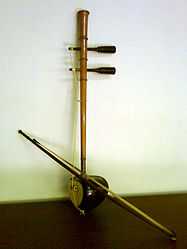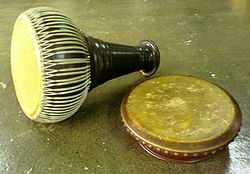Saw u
 | |
| Classification | String instrument (bowed) |
|---|---|
| Related instruments | |
| Tro u | |
The saw u (Thai: ซออู้, pronounced [sɔː ʔûː], rtgs: so u, also spelled saw ou) is a Thai bowed string instrument. It has a lower pitch than the saw duang and is the lowest sounding of the saw family.[1]
The soundbox is made from a coconut shell that is covered on the open front by cowskin. The saw u is held vertically and has two silk strings that are played with a bow. The bow is between the strings and the player tilts the bow to play each string. The bow is made out of horse tail hair like every other bow and needs to have rosin put on occasionally just like a western stringed instrument. The saw u is a very fragile instrument and is played traditionally on the lap sitting down. The saw u can be played as a solo instrument in some cases but is mainly used for the backbone in some ensembles because of its rich, dark, and mellow tone. The saw u performs its best when playing slow to moderate paced melodies. The sound that the saw u makes is more fit for those types of songs rather than fast paced melodies. The morn (bridge) that rests at the bottom is extremely sensitive and drifts over time, causing changes in tone. The saw u is similar to the Cambodian tro u and was developed by the Chinese into the yehu.
History
The evidence and history about the Saw U is based on texts from the early Ayutthaya period. This was when Thai musical instruments were played and adapted very often. It was announced during the reign of King Baromtrailorknart (สมเด็จพระบรมไตรโลกนาถ) that music was to be used in royal ceremonies and other celebrations. The King ruled from 1991 to 2031 (Thai date)(1448~1488 AD) and this was when Saw U was introduced in Thailand. The royal law of Siam during the period, mentioned in number 15 and 20 announced a penalty for anyone playing musical instruments disturbing the surroundings especially disturbing the palace, as sometimes happened when the player played on a boat passing the palace. The instruments listed include fiddle, flute, clarinet, and zither or stringed lute.[2] A letter written by Simon de La Loubère (Du Royaume de Siam), the French ambassador to Thailand during the rule of King Baromtrailorknart, mentioned “A royal barge procession was the King’s transportation, while heading to the destination the musicians played Saw U with other instruments and the people shouted with joy singing along the river”. Both the royal law and the letter of Simon de La Loubère talked about the Saw U. The Saw U used to be played only for royals, but it spread out to the commoners for entertainment, arts, and shows.[2]
References
External links
| ||||||||||||||||||||||||||||||||||||||||||||||||||
